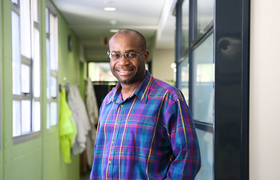Newly launched i2i helps young researchers negotiate IP process
12 May 2022 | Story Helen Swingler. Photo Supplied. Voice Cwenga Koyana. Read time 7 min.
The University of Cape Town’s (UCT) newly launched From Idea to Impact (i2i) programme will support its young innovators in science, technology, engineering and mathematics (STEM) on the often technical and complex journey from research to patenting and commercialisation.
Based in Research Contracts and Innovation (RC&I), i2i was launched at a webinar on 26 April, World Intellectual Property (IP) Day, hosted by RC&I’s new venture support manager and programme lead Niall Naidoo. The online event included young innovators and researchers at different stages of their commercialisation journey, as well as UCT support staff and an IP legal expert.
Naidoo is on a mission to embed intellectual property thinking among these young researchers. The development will fill a massive gap by upskilling UCT’s bright young minds in the foundations of tech commercialisation: how they can use IP rights to achieve their goals, generate income, create jobs, tackle local and global challenges, and support national and community development. This is also the focus of World IP Day 2022 with its theme “Intellectual Property and Youth: Innovating for a better future”.
Protecting innovation
The theme is a close match to RC&I’s daily work of looking after the route to commercialisation, said Liesl Hattingh, marketing specialist at RC&I. They assess IP and assist with a strategy on how and when to file disclosures and patents as well as help structure IP and commercialisation agreements. They also advise on how IP is managed from a spin-out (creation of a new company) perspective.
“IP is a very important tool in the innovation space,” said Hattingh. “The new i2i will facilitate that development by supporting commercialisation for deep technology start-ups.”
These ideas often emanate from master’s and doctoral research in STEM subjects.
“Our mandate is to manage UCT’s IP and facilitate the technology transfer.”
Deep technology or “hard tech” refers to technology emanating from science, health sciences and engineering that is not the predominantly information communication-focused technology commonly referred to as “tech”, said Dr Andrew Bailey, senior manager of Innovation Services in RC&I.
“The commercialisation often involves significant capital expenses or infrastructure and equipment, scale-up, as well as regulatory and or compliance with standards, such as those linked to the pharmaceutical, chemical, radar and medical devices sectors.”
Deep tech fields like artificial intelligence (AI), advanced materials, blockchain, biotechnology, robotics, drones, photonics and quantum computing are moving more and more rapidly from early research to market applications. As such, deep tech has a different business model and timeline.
“Our mandate is to manage UCT’s IP and facilitate the technology transfer – the movement from applied research into market [applications] so that you can see society using your research in practice,” said Naidoo. This relies on close relationships with industry.
“We constantly engage with industry, find opportunities and then facilitate the working relationship between those in academics and industry,” said Naidoo.
The i2i programme for young innovators has six components:
- IP management
- Technology commercialisation
- New product development
- Project management
- Business models
- Funding strategies.
Personal experiences
Five speakers shared their IP experiences during the webinar.
Manfred Braune, UCT’s Director of Sustainability, talked about using UCT as a test bed for green innovations and the Vice-Chancellor’s Khusela Ikamva project to “secure the future”. Candidate attorney at Von Seidels IP law firm Kimberley Kasper discussed trends and gave an overview of IP.
An immunologist at the South African Tuberculosis Vaccine Initiative (SATVI), Dr Munyaradzi Musvosvi, is working on a TB mRNA vaccine and has recently filed a disclosure. Dr Bevan Jones of spin-off Elemental Numerics (Pty) Ltd discussed their work in computational mechanics with clients in the aerospace sector as well as prospective developments in undersea blasting and renewable energy. Dr Sarah Carroll, a molecular and cellular biologist, talked about the recent MariHealth Solutions (Pty) Ltd spin-off, aimed at the aquaculture industry.
Speaking about the value of RC&I’s support, Dr Musvosvi said IP is usually discussed only at the end of a project, “in the mad rush to file the paperwork before publishing the research findings”.
“Trying to pair that with ensuring you disclose and protect your IP initially is critical learning.”
Dr Jones works in the computational fluid dynamics field and added that it’s essential to begin thinking about IP at an early stage. His own process took 10 years, and the IP is finally bringing in revenue.
“In 2012 and 2013 I wasn’t thinking about IP. But now that has become an important aspect of what the team does.”
“Innovation and technological advancement is what drives human evolution.”
Dr Carroll worked with colleague Associate Professor Dr Vernon Coyne in molecular and cellular biology to develop the commercial innovations behind MariHealth Solutions. These are aimed at aquaculture health: monitoring, managing, helping to develop diagnostic and therapeutical solutions for improved aqua farming.
“Innovation and technological advancement is what drives human evolution,” said Carroll. “And developing a strong understanding of IP protection and rights early in your career encourages and fosters innovation and incentivises young researchers to push boundaries and solve global problems.”
She added, “Climate change is probably the most pervasive crisis that we face today with extinctions of vulnerable species on the rise. IP rights and really sound and robust IP strategy are crucial for creative and sustainable innovations.”
Protecting and commercialising innovation also means looking hard at what already exists and where a young researcher may be able to fill a gap, said Kasper, an IP legal advisor.
“See what’s available in the field you are researching. But if you don’t see it on the market, it doesn’t mean it’s not patentable.”
“Be careful about what you share.”
The main questions to ask before applying for patents are:
- What is the problem your research solves?
- What do you need to build or make to solve that problem?
And while an invention may be good news for the world, before publishing a research paper, touting it on social media or in conference papers, make sure it’s protected and won’t hurt you later, Kasper advised.
“Be careful what you share. Going public can destroy your ability to get a patent because there can’t be any public disclosures before an application is filed,” she said. “Involve RC&I as soon as possible, even if your idea isn’t fully developed. Ask questions about what you need to do.”
It’s not a simple process either, said Carroll.
“It’s very drawn out. It’s about being willing to learn and listen to advice – and [about] asking questions.”
(To apply for the course, contact Niall Naidoo at niall.naidoo@uct.ac.za or sign up at Idea to Impact. The programme starts on 30 May 2022.)
 This work is licensed under a Creative Commons Attribution-NoDerivatives 4.0 International License.
This work is licensed under a Creative Commons Attribution-NoDerivatives 4.0 International License.
Please view the republishing articles page for more information.










